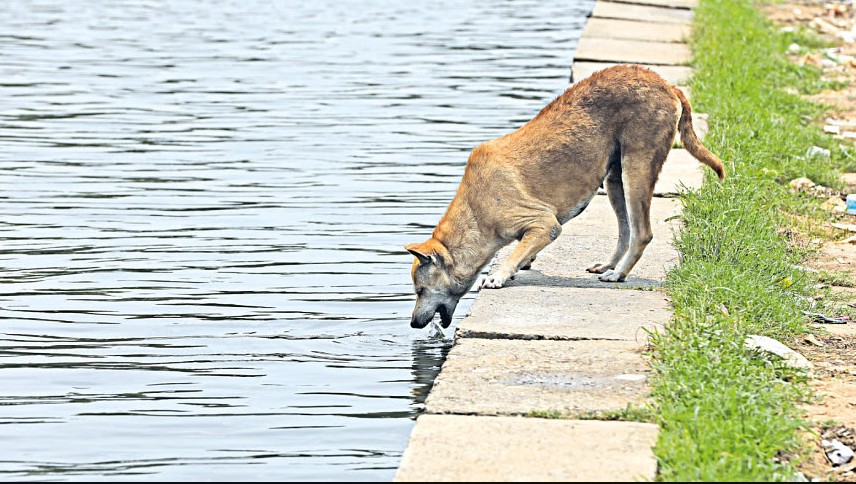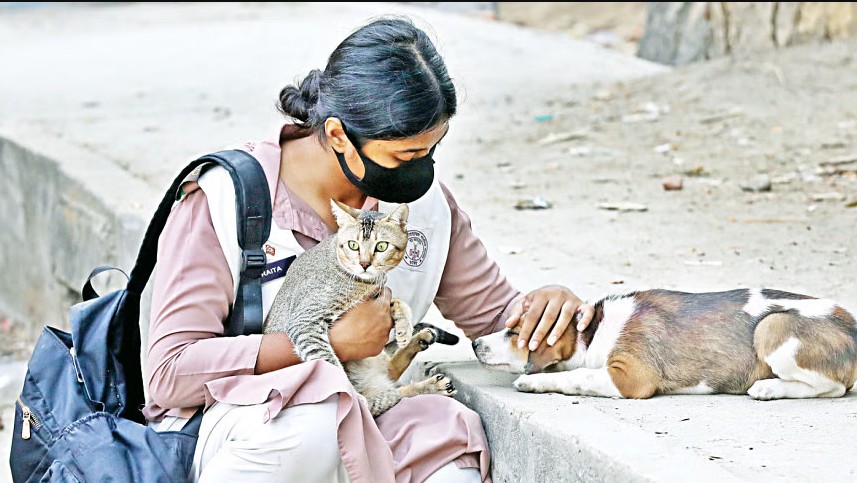Heat, hunger, and homelessness
As the climate crisis worsens, its effects in Bangladesh are becoming increasingly visible and destructive. However, amid the growing discussions about rising temperatures, flooding, and urban resilience, one vulnerable group remains largely overlooked: the stray animals of Dhaka.
Roaming the city’s alleys, streets, and marketplaces, thousands of stray dogs, cats, and other animals are increasingly exposed to the harsh effects of climate change. Unbearable heat, water shortages, and food scarcity have turned survival into a daily struggle for these silent victims of an urban environment that is becoming ever more hostile.
Urban Heat and Animal Suffering
Over the past few years, Dhaka has experienced increasingly severe heatwaves, with temperatures soaring above 40°C, far beyond historical norms. This temperature rise, compounded by the city’s urban heat island effect, poses a serious threat to animals living on the streets without access to shade, clean water, or proper nourishment.
“Many of the animals we rescue show signs of heatstroke, severe dehydration, and skin infections caused by continuous exposure to hot pavements,” says Dr Nasima Jahan, a senior veterinarian with Obhoyaronno, a leading animal welfare organisation in Bangladesh. “Unlike humans, these animals have limited means to cool themselves, and when they’re malnourished, their tolerance is even lower.”
Increased thunderstorm activity, driven by shifting monsoon patterns, also triggers panic among animals. Loud noises and sudden downpours force them to flee their familiar territories, increasing their risk of injury or death in traffic.
Disappearing Resources in a Changing City
Urban expansion and climate change have combined to shrink the availability of resources that once helped sustain stray animals. Water sources, such as roadside puddles and drainage canals, often dry up during extreme heat. Similarly, food scraps from local eateries—once a primary source of nutrition—are now scarce due to improved waste management and economic hardship among vendors.
“Earlier, we used to share leftover rice with street dogs at the end of the day,” says Monir Hossain, a tea stall owner in Farmgate. “Now, I barely have enough to eat myself during heatwaves. There’s hardly anything left for them.”
Public parks, small ponds, and green spaces that once offered shade and comfort to animals are rapidly being replaced by concrete developments, particularly in low-income and informal settlements.
Rising Tensions Between People and Animals
The climate crisis has not only worsened the plight of animals but has also intensified human-animal conflict. As more climate migrants pour into Dhaka’s slums and streets, competition for space and resources grows, often leading to animosity towards stray animals. Fear of disease, particularly rabies, continues to fuel cruelty and neglect.
“When we try to place water bowls in our neighbourhood for stray dogs, some residents throw them away,” says Tamanna Rahman, a university student and animal welfare volunteer. “They think the animals bring disease, but these creatures are simply trying to survive in unbearable conditions.”
Heat-stressed and malnourished animals may become more aggressive or disoriented, further straining public tolerance and compassion.

Community Action and Climate-Resilient Solutions
Despite the challenges, there are hopeful signs of grassroots efforts that recognise the interconnectedness of animal welfare and urban climate adaptation. In several neighbourhoods—including Dhanmondi, Mohammadpur, and Gulshan—youth-led groups and NGOs have set up hydration stations and feeding corners for stray animals. Local tea stall owners and shopkeepers are also being engaged to maintain water bowls during the hotter months.
“These initiatives show that even small actions can make a big difference,” says Rifat Mahmud, an organiser with Dhaka Paws, a local animal advocacy group. “Caring for animals doesn’t just help them—it also strengthens our community’s empathy and resilience.”
Climate-resilient urban planning must begin to incorporate animal-friendly policies. This includes the provision of shaded spaces, the inclusion of veterinary services in emergency planning, and the implementation of humane birth control and vaccination programmes to ensure public safety without resorting to culling or poisoning.
The Need for Inclusive Climate Policy
While Bangladesh has made significant strides in climate adaptation and disaster preparedness, animals remain largely absent from national and municipal planning. The neglect of non-human species in climate policies risks undermining holistic resilience and public health.
“Stray animals are part of our urban ecosystem and deserve protection, especially in times of crisis,” says Sharmeen Khan, a legal advisor focusing on animal rights in South Asia. “They don’t contribute to carbon emissions or pollution, yet they suffer the consequences. Leaving them behind is not just unethical—it’s shortsighted.”
Shared Responsibility in a Warming World
In the heart of Dhaka, as temperatures continue to rise and green spaces disappear, the survival of stray animals grows increasingly precarious. Their suffering is a stark reminder that climate change is not just a human issue—it affects every living being that calls this planet home.
We must ask ourselves: can our fight against climate change be truly just and sustainable if we continue to ignore those who cannot speak for themselves?
A climate-resilient Dhaka must not only be smarter, cleaner, and greener—it must also be kinder.
Afrina Momotaj is an animal rescuer.
Source Courtesy: daily star online.





